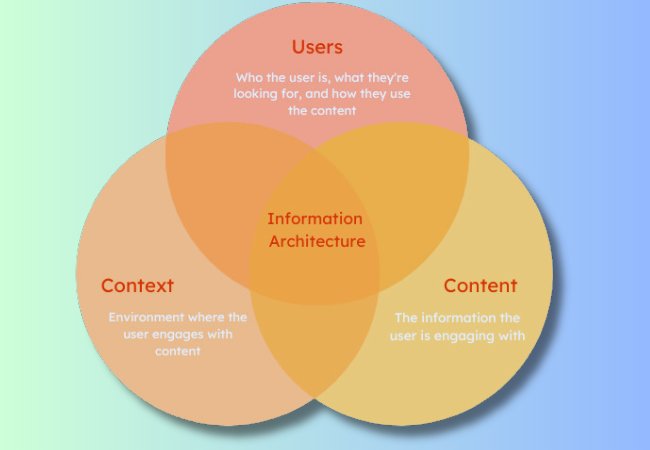Model Explains Information Architecture

An Overview
Information architecture (IA) is the discipline of making information searchable and understandable. It involves organizing, structuring, labeling, and presenting information in a way that helps users achieve their goals and tasks. IA is used in both physical and digital spaces, such as museums, libraries, websites, and applications.
Benefits and Challenges of IA
IA is an essential part of user experience (UX) design, as it affects how users interact with and perceive the information environment. Some of the benefits are:
- It helps users search for what they are looking for quickly and easily.
- It helps users understand the context and scope of the information available.
- It helps users navigate through complex and large amounts of information.
- It helps users make sense of the information and its relevance to their needs.
- It helps users complete their tasks and achieve their goals.
However, IA also comes with some challenges, such as:
- It requires a deep understanding of the users, content, and context of the information environment.
- It requires a balance between user needs, business goals, and technical constraints.
- It requires a clear and consistent labeling system that matches the users’ mental models and expectations.
- It requires a flexible and adaptable structure that can accommodate changes in the information environment.
- It requires a rigorous evaluation process that can measure the effectiveness and usability of the IA.
Components and Principles of IA

According to Louis Rosenfeld, Peter Morville, and Jorge Arango, the authors of Information Architecture for the World Wide Web1, there are four main components of IA:
- Organization schemes and structures: How you categorize and group information into meaningful and logical units.
- Labeling systems: How you name and describe the information to make it understandable and recognizable.
- Navigation systems: How you provide ways for users to move through information and access different parts of it.
- Search systems: How you enable users to look for specific information using keywords or filters.
These components are informed by three factors that form the “information ecology” of the information environment1:
- Users: The audience, tasks, needs, information-seeking behavior, and experience of the people who use the information environment.
- Content: The document or data types, content objectives, volume, existing structure, governance, and ownership of the information available.
- Context: The business goals, funding, culture, technology, politics, resources, and constraints of the organization or entity that owns or provides the information environment.
To design effective IA, you need to consider these factors and how they interrelate with each other. You also need to follow some general principles that guide your IA decisions2:
- Clarity: The information should be clear, concise, consistent, and accurate.
- Simplicity: The information should be easy to comprehend and use.
- Relevance: The information should be meaningful and useful to the users’ needs and goals.
- Coherence: The information should be logically organized and connected.
- Balance: The information should be balanced between breadth and depth, detail and overview, specificity and generality.
Models and Examples of IA
There are many ways to organize and present information depending on the nature and purpose of the information environment. Some common models for IA are3:
- By topic: The information is grouped by subject or theme. For example, a news website may have sections for politics, sports, entertainment, etc.
- By task: The information is grouped by action or function. For example, a banking website may have sections for checking account balances, transferring money, paying bills, etc.
- By audience: The information is grouped by user type or role. For example, a university website may have sections for students, faculty, staff, alumni, etc.
- By format: The information is grouped by document or data type. For example, a media website may have sections for videos, podcasts, articles, etc.
How to Design and Evaluate IA
The process of designing and evaluating IA can vary depending on the scope and complexity of the project, but it generally involves the following steps4:
- Research: Gather and analyze data about the users, content, and context of the information environment. Use methods such as interviews, surveys, card sorting, content audit, competitor analysis, etc.
- Strategy: Define the goals, scope, and requirements of the IA. Use methods such as personas, scenarios, user stories, sitemaps, etc.
- Design: Create the structure, labels, navigation, and search systems of the IA. Use methods such as wireframes, prototypes, taxonomies, etc.
- Test: Evaluate the usability and effectiveness of the IA. Use methods such as usability testing, heuristic evaluation, analytics, etc.
- Iterate: Refine and improve the IA based on the feedback and results of the testing. Repeat the steps until the IA meets the desired criteria.
Conclusion:
Information architecture is a vital part of UX design that helps users find and understand information. It involves organizing, structuring, labeling, and presenting information in a way that suits the users’ needs and goals. It requires careful consideration of the users, content, and context of the information environment. It also requires a systematic process of research, strategy, design, testing, and iteration. By following the principles and models of IA, you can create information environments that are clear, simple, relevant, coherent, and balanced.













